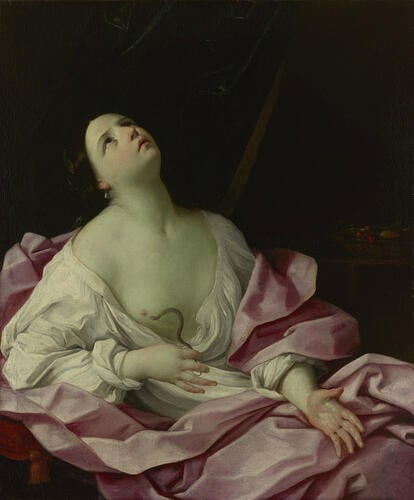-
1 of 253523 objects
Cleopatra with the Asp c. 1628
Oil on canvas | 114.2 x 95.0 cm (support, canvas/panel/stretcher external) | RCIN 405338
-
Palma Giovane asked his friend and fellow artist Guido Reni to create a painting of Cleopatra, to be judged in competition with his own works and those of Niccolò Renieri and Guercino. The painting depicts the final moments of Cleopatra, as she succumbs to the bite of the snake held against her breast. Reni did not win the competition, but Renieri later bought the painting.
This painting can be dated to the latter part of the 1620s. According to Reni’s biographer Carlo Cesare Malvasia, the painting was commissioned by a Venetian merchant called Boselli at the instigation of Reni’s friend and colleague Palma Giovane. Giovane wrote to convince Reni to create a painting of Cleopatra for Boselli, so that it could be judged in competition with his own works and those of Niccolò Renieri and Guercino. During his own lifetime Reni’s genius was particularly identified with images of suffering female beauty – Magdalens, Lucretias and Cleopatras. Malvasia recounts that while Reni’s painting of Cleopatra did not win the contest, nevertheless after Boselli’s death it was bought by Renieri. A description of Renieri’s large art collection of 1666 mentions a painting of a half-length figure of Cleopatra seated with a small table in the background, with very similar measurements to the Royal Collection picture. In 1675, this painting appears listed amongst those sold by Renieri to Domenico Fontana.
Palma Giovane died in 1628, which provides a terminus post quem for the execution of the work. Indeed, the evidence for such a dating is further supported by the stylistic qualities of the work. The painting is typical of Reni’s work of the late 1620s and early 1630s, which relied upon firm brushwork and an enamel-like finish to the paint surface.
The subject of the painting depicts the final moments in the life of the Egyptian Queen, Cleopatra, as she prepares to commit suicide, as recounted by Plutarch in his Lives of the Caesars. Guido Reni has chosen to represent the moment when the asp (which has been smuggled in to Cleopatra in the basket of figs depicted in the background) is about to deliver the lethal bite into her bare breast. Reni heightened the dramatic potency of the image through the stark contrast between the fair skin of Cleopatra and the dark background of the painting. Her form is carefully modelled and she is enveloped in swirls of convincingly rendered pink drapery. The naturalism of her expression and the lifelike quality of her flesh are depicted through Reni’s conscientious draughtsmanship and his expert use of colour and tonal variations to build form. His particular attention to detail can be seen in the gold edging on the rose-coloured drapery and the reflection of light captured in Cleopatra’s pearl earring.
Reni often reworked successful compositions; he returned frequently to the subject of Cleopatra over the course of his career and made many variants of this painting. Versions are found in the Museo Capitolino, Rome, the Prado, Madrid and the Pitti Palace, Florence. The Royal Collection painting is of exceptional quality and one of the finest depictions of this subject in Reni’s oeuvre.
The painting appears in Pyne's illustrated Royal Residences of 1819, hanging in the King's Dressing Room at Windsor Castle (RCIN 922105).
Catalogue entry adapted from The Art of Italy in the Royal Collection: Renaissance and Baroque, London, 2007 and The First Georgians: Art and Monarchy 1714-1780, London, 2014.Provenance
Possibly belonged to Boselli, Venice, by 1628; Nicholas Renieri and Domenico Fontana; acquired by Frederick, Prince of Wales, and recorded in the Prince's Dressing Room at Leicester House in 1749
-
Medium and techniques
Oil on canvas
Measurements
114.2 x 95.0 cm (support, canvas/panel/stretcher external)
147.0 x 128.7 x 11.0 cm (frame, external)
Category
Object type(s)
Other number(s)
Alternative title(s)
Cleopatra, Queen of Egypt (d.30 B.C.) with the asp
The death of Cleopatra
